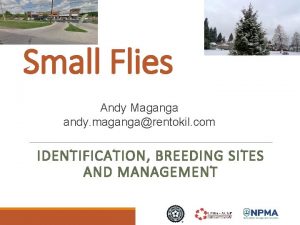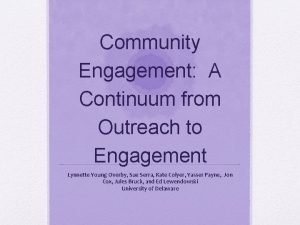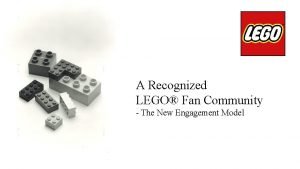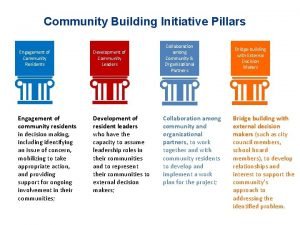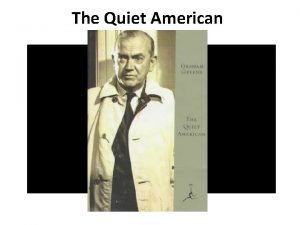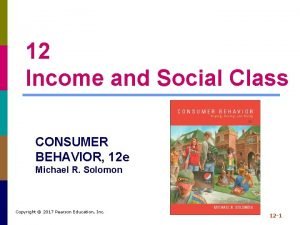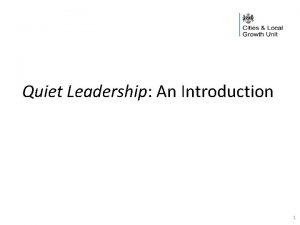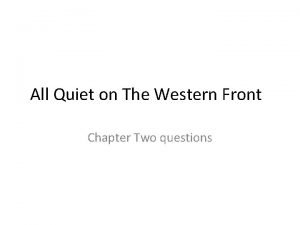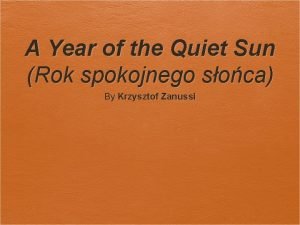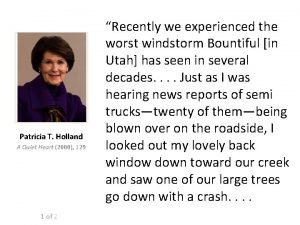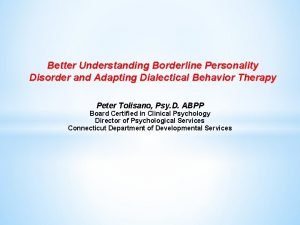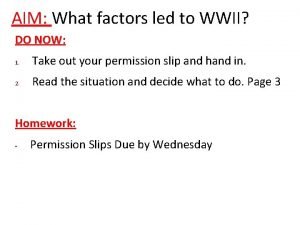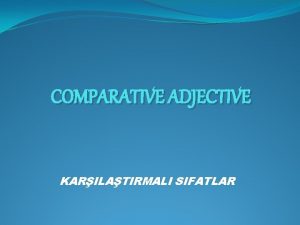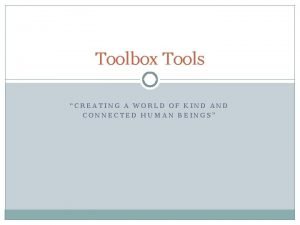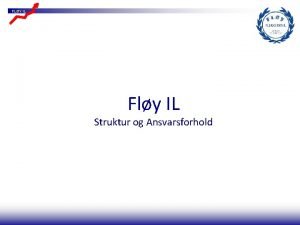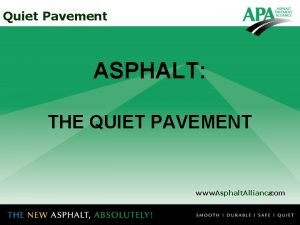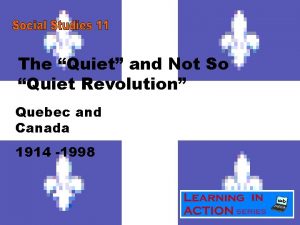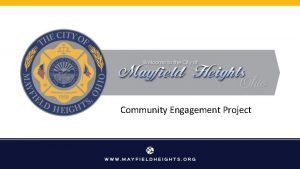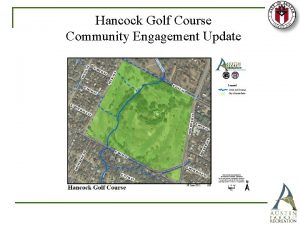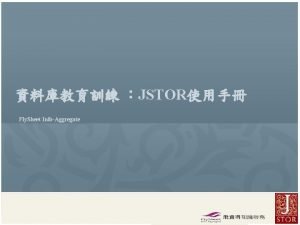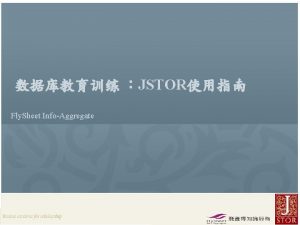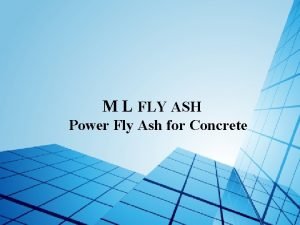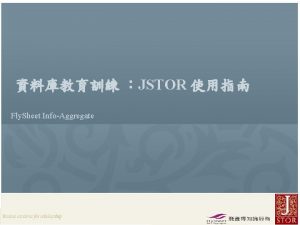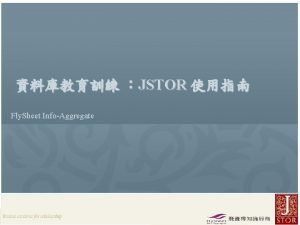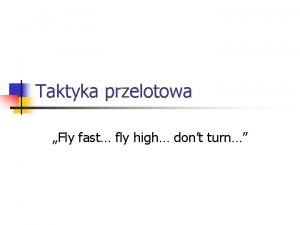i Fly Quiet Community Engagement Materials i Fly



































- Slides: 35

i. Fly. Quiet Community Engagement Materials i. Fly. Quie

Section 1: Introduction i. Fly. Quie

What is i. Fly. Quiet? • Initiative to address helicopter noise issues through community outreach and engagement ◦ Establish a consistent dialogue with communities affected by helicopter noise ◦ Educate communities about steps operators are taking to reduce noise i. Fly. Quie

What is Fly Neighborly? • Fly Neighborly: Holistic approach to mitigating helicopter noise issues ◦ Noise abatement flight procedures ◦ Route planning ◦ Community outreach • Based on 40+ years of helicopter noise manufacturer and government research • Formal training programs available through FAA-WINGS and HAI Online training for FAA-WINGS credit was created by Volpe on behalf of the FAA. https: //go. usa. gov/x. QPCW i. Fly. Quie

Fly Neighborly Research • Scientific, quantitative approach to measuring sound emissions • Quantify acoustics for different maneuver conditions i. Fly. Quie

Who supports i. Fly. Quiet and Fly Neighborly? • HAI’s Fly Neighborly Environmental Committee ◦ Membership comprised of U. S. and international public and private organizations • Additional support from ◦ Federal Aviation Administration (FAA) ◦ National Aeronautics and Space Administration (NASA) ◦ US DOT’s Volpe National Transportation Systems Center (Volpe) ◦ Department of Defense (DOD) ◦ Vertical Flight Society (VFS) ◦ Academia (Pennsylvania State University) i. Fly. Quie

Section 2: Sound Measurement and Perception i. Fly. Quie

Sound Levels and Decibels • Sound: Measured in decibels (d. B) on a logarithmic scale • A-weighting – developed to account for how humans perceive sound Source https: //www. faa. gov/regulations_policies/policy_guidance/noise/basics/ i. Fly. Quie

Perception of Sound Change in Sound Level Perceived Change to Human Ear ± 1 d. B Not Perceptible ± 3 d. B Threshold of Perception ± 5 d. B Obvious Change ± 10 d. B Twice / Half as Loud ± 20 d. B Fourfold or ¼ as Loud i. Fly. Quie

Sound Propagation • Sound level decreases as the distance from the source increases Sound Pressure Levels in a Free Field • Contributing factors ◦ Distance divergence (spreading) ◦ Atmospheric absorption Source: OSHA Technical Manual, Section III Chapter 5 i. Fly. Quie

Noise Metrics • Noise metric: Quantity that measures effect of noise on environment- federal agencies commonly use 4 noise metrics: ◦ Maximum Noise Level (Lmax): Measure of the highest sound level occurring during single event ◦ Sound Exposure Level (SEL): Total sound energy of single event ◦ Equivalent Sound Level (Leq): Average sound level of all events over specific time period ◦ Day-Night Average Sound Level (DNL): Average sound level over 24 hours, with a penalty to nighttime events Source: PSU Noisequest https: //www. noisequest. psu. edu/noisebasics-noisemodels. html i. Fly. Quie

Section 3: Helicopter Noise Basics i. Fly. Quie

Helicopter Noise Emissions • Helicopter noise is complex and comprised of multiple noise sources • Different operating conditions cause different sound characteristics, quality, loudness, and directivity • 4 primary types of noise: ◦ Thickness and High Speed Impulsive (HSI) noise ◦ Blade Vortex Interaction (BVI) noise ◦ Loading and Broadband noise ◦ Tail Rotor Interaction (TRI) noise Source: K Brentner, PSU i. Fly. Quie

High Speed Impulsive (HSI) Noise • Higher rotor speed and forward airspeed compound • Can travel over very long distances • Pilots cannot hear this in the aircraft i. Fly. Quie

Blade Vortex Interaction (BVI) Noise • Created when rotor blades pass through or close to the wake of the preceding blades • Impulsive and directional • Can travel long distances • Most people will find BVI annoying i. Fly. Quie

BVI Visualization i. Fly. Quie

Section 4: Fly Neighborly Recommendations i. Fly. Quie

Noise Abatement in Flight - Safety Comes First! • As always, safe flight given priority over noise • Noise abatement profiles require ◦ Technical proficiency ◦ Training ◦ Mission planning / execution i. Fly. Quie

Fly Neighborly Considerations • Key Considerations • • • Safety Flyability Passenger Acceptability Duration / Operational Costs Routing Requirements • What’s in the Fly Neighborly Toolkit • • • Routing Changes Altitude Airspeed Departure: Rate-of-Climb Arrival: Rate-of-Descent i. Fly. Quie

Fly Neighborly - Routing • Routing should be considered in pre-flight planning • Avoid noise-sensitive areas i. Fly. Quie

Fly Neighborly - Altitude Considerations • Doubling of height decreases sound level directly under flight path by 6– 7 d. B(A) • Tripling the height reduces sound levels by approximately 10 d. B(A) • But ◦ Flying higher not always safe or practical ◦ Increases affected area i. Fly. Quie

Fly Neighborly - Speed Considerations • Lower airspeed generally reduces noise level • But – ◦ Lower airspeed increases overflight duration i. Fly. Quie

Fly Neighborly - Departures • Steeper take-offs reduce the area affected • But ◦ Pilots must balance safety risks i. Fly. Quie

Noise During Arrival • Optimized arrivals can reduce noise footprint • Steeper rate of descent results in less noise exposure • Staying higher longer reduces noise i. Fly. Quie

Section 5: Fly Neighborly in Action i. Fly. Quie

Link to Demonstrations • The videos in the following slides will require an internet connection for playback. They may be accessed via You. Tube at: https: //www. youtube. com/playlist? list=PLm_7 Y 91 JGJbvtz. BP Au. HMHOj. X 3 riok_B 2 K i. Fly. Quie

i. Fly. Quie

i. Fly. Quie

Noise Visualization: Standard vs. Fly Neighborly Approach Standard Fly Neighborly i. Fly. Quie 29

Bell 430 Left and Right Turns 95 90 i ii iii 85 80 d. BA 75 70 iv v vi Courtesy: NASA i. Fly. Quie

Fly Neighborly Departure i. Fly. Quie

i. Fly. Quie

Section 6: Fly Neighborly Limitations i. Fly. Quie

Why Can’t Fly Neighborly Be Used Every Day? • Safety: Flying higher or with steeper climb descent rates may be unsafe in certain circumstances • Pilot workload: Procedures which require high pilot workload to execute are inherently unsafe • Air traffic: Nearby fixed-wing or helicopter traffic may preclude use of certain procedures • Weather: May affect air traffic patterns, flight ceilings and safety • Passenger comfort: G-forces • Re-routing may just move the noise problem i. Fly. Quie

As always, fly safe out there! i. Fly. Quie
 Drain flies
Drain flies Fly eagle fly characterisation
Fly eagle fly characterisation Kpis for community engagement
Kpis for community engagement Community engagement continuum
Community engagement continuum Ppst domain 6 explanation
Ppst domain 6 explanation Lego community engagement
Lego community engagement Community building initiative
Community building initiative Go noodle cant stop the feeling
Go noodle cant stop the feeling Direct materials budget with multiple materials
Direct materials budget with multiple materials Harmful useful materials
Harmful useful materials Natural materials and man made materials
Natural materials and man made materials Adopting and adapting teaching materials
Adopting and adapting teaching materials What type of irony is this
What type of irony is this The quiet american genre
The quiet american genre Quiet vs loud brand signals
Quiet vs loud brand signals The little cricket
The little cricket Quiet leadership
Quiet leadership Himmeltoss
Himmeltoss All quiet on the western front test
All quiet on the western front test Year of the quiet sun
Year of the quiet sun Quiet model
Quiet model Benefits of studying in a quiet place
Benefits of studying in a quiet place Patricia t holland
Patricia t holland Quiet borderline personality disorder
Quiet borderline personality disorder Sidetalking
Sidetalking Intermolecular forces comic strip
Intermolecular forces comic strip Quiet leadership
Quiet leadership Kenning is
Kenning is Shh-hh he'll be quiet now maybe analysis
Shh-hh he'll be quiet now maybe analysis All quiet characters
All quiet characters Comparative adjective
Comparative adjective Please be quiet. i (try) to sleep
Please be quiet. i (try) to sleep Quiet safe place tool
Quiet safe place tool Make it your ambition
Make it your ambition Barcodeqr
Barcodeqr Quiet night thoughts
Quiet night thoughts
